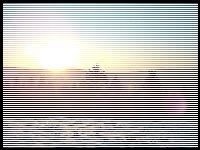Image composition
The classic television picture is made up of individual lines. These are transmitted one after the other and displayed one below the other. Due to the inertia of the eye , this process is not or barely visible.
With the PAL standard used in Germany, a complete television picture consists of 625 lines and is written 25 times per second. In other countries, different frame rates (29.997 Hz) are sometimes used.

However, a refresh rate of 25 Hertz would lead to unbearable flicker. An image is therefore divided into two fields of 312 ½ lines each and these fields are displayed at a frequency of 50 Hertz. In the first field, all odd lines are transmitted and in the second field all even lines. The offset of half a line means that the lines of the successive fields are each written in the spaces of the previous field. This procedure is the so-called (2: 1) interlace procedure .
Displayed in black at the top left, the image build-up starts. When the right edge of the picture is reached, a line sync pulse in the television signal triggers the return line. The electron beam of the picture tube is blanked for the time of the return and also runs very quickly. The display of the next line starts on the left edge. When the lower edge of the picture is reached, a few lines with identification pulses (front-end, picture sync pulse, rear-end) follow for the picture return (shown in green). This takes a few picture lines, in which the beam of the tube is also blanked and no picture information is transmitted. These lines are used for the VPS system, teletext or for the video data system that was used for a while, with which programs for PC , Amiga and Atari ST were transmitted.
The new picture starts again at the top left (shown in blue in the picture) and due to the interlacing process, the new lines are written between those of the previous field.
Structure of a full picture by superimposing two fields
In the first field the odd lines (1,3,5, ...) are written by the electron beam, in the second field the even lines (2,4,6, ...). The sluggishness of the eye and the afterglow of the phosphor layer of the picture tube result in the perception of a full picture .


